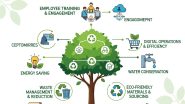Transformation in the retail business of buying or selling has transformed the business operation. Today, companies are fulfilling customer needs and demands via prompt delivery options, delivery of excellent services and more.
The success of the business is determined by many factors, however lead time, increased customer satisfaction and improved cash flow are the primary key factors in the process.
In this article, we will discuss the ways to reduce lead time, increase customer satisfaction and improve cash flow simultaneously in the business.
Your lead time is important and reducing it can have a major impact on your business
Different Ways To Reduce Lead Time, Increase Customer Satisfaction & Improve Cash Flow
- Found Diversified and Remove Unreliable Supplier:
Diversified suppliers help maintain quality supply practices to achieve better performance in quality, flexibility, reliability, cost and design. The materials not only can be sourced from international suppliers, but also many raw materials can come from domestic suppliers. It helps in quickly reducing the lead time.
Pro Tip: If you are looking to change your product, always ensure to be stocked with enough inventory to get through the changeover period. This will reduce the chances of inventory deficits and help to run to the new supplier more quickly.
- Choose Close-By Vendors:
In the global marketplace, access to more than one vendor has become an easy task however, while chasing the best price from the suppliers across the globe, it leads to waiting for weeks for products to be shipped overseas. This increases the lead time and also complicates the process of returning faulty or unwanted products. One of the easiest lead time reduction strategies for suppliers is to give property to the vendors located nearby to your warehouse or manufacturing plant.
Tip: If you are unable to find a local supplier that can compete on price, consider placing larger orders but frequently from international vendors and keeping a large inventory in hand.
- Share Demand Forecasts With Suppliers:
In an industry that naturally fluctuates its orders monthly, the suppliers must prepare for larger-than-normal orders. It helps in understanding the expectation of increasing demands of products as early as possible. As a result, it gives a message to the buyer that suppliers are not only prepared to handle an exceedingly larger order but also prepared for a quick delivery order.
- Make In-house External Processes:
External processes increase efficiency, reduce costs and gain more control over business operations. Setting up the In-house external processes ensures all facilities are under one roof and decreases outsourcing the products from third-party suppliers. This requires a significant investment upfront but the long-term saving makes the financially feasible. So, by keeping everything in-house, you can ensure that your team is trained to handle every aspect of your business with precision & expertise, infrastructure for growth allows you to scale with profits.
- Automate Orders Increase Workflow:
Having a raw material gives a kickstart to start the production process, however, poor performance leads to suffering in lead time. Before setting up the production house, consider these pointers:
- How much time it takes you to get customer purchase orders in the system?
- How much time does it take you to move engineering change of orders from production and QA?
- How often has the process stopped as a result of internal miscommunication?
- How many times do the orders get lost entirely?
- Multitasking of Things:
For better results, certain processes have to be completed before others can be started and there will be no way around it. Therefore, identifying processes where individuals can complete tasks at the same time. It increases productivity and reduces the lead time even further.
- Enhance Internal Communication:
Communication and order processing is an “all hands on deck” process, however, not collaborating well internally will create unnecessary delays in the production process. Using order entries as an instance, if your process involves multiple steps that require input from several people. This will increase the chance of wasting time, especially if you're using paper documents that are difficult to track. Keeping paper-based projects sitting on someone's desk can increase lead time and the likelihood of losing important documents.
Poor communication is a significant challenge, often a symptom of deeper issues, but manufacturers have several options to eliminate bottlenecks. One solution is implementing a workflow system that immediately routes order-related documents from one department or user to the next. It notifies users that a project needs their attention.
- Improve Communication With the Customers:
As per the studies, communication is the primary key to increasing customer satisfaction and loyalty however, it reduces the lead time. Keeping the customer up-to-date about the orders, increases their trust and loyalty towards the supplier. Sending order notifications with the automation of technology decreases the efforts and increases satisfaction.
- Eliminate Bottlenecks:
Improving efficiency and accountability can reduce lead time and increase customer satisfaction. Bottlenecks such as running processes in series, multiple hand-offs between departments, machine breakdown or changeover should be eliminated for better results. Running processes in parallel, consolidating tasks in one department, performing schedule maintenance and more should be implemented instead of bottlenecks.
- Improve Cash Flow and Liquidity:
By analyzing sales data across multiple channels and taking into account current market conditions, you can improve the accuracy of your demand forecasts. This, in turn, can help you plan your inventory requirements more effectively for future sales. By avoiding overstocking, you can operate with less capital tied up in unsold inventory sitting around in the warehouse.
One of our biggest accomplishments has been setting up real-time inventory tracking systems, which enable us to track inventory levels accurately. “This approach reduces the chances of running out of stock or experiencing an overstock situation”- Priyanka Swamy of Perfect Locks.
In conclusion, reducing lead time, increasing customer satisfaction, and improving cash flow are crucial factors for the success of any business. By implementing the strategies discussed above, such as diversifying suppliers, choosing local vendors, sharing demand forecasts, setting up in-house external processes, automating orders, multitasking, enhancing internal communication, and improving communication with customers, businesses can achieve these goals simultaneously.
These strategies require some upfront investment, but they can lead to significant long-term savings and increased profitability. By focusing on these key factors, businesses can stay competitive in the ever-changing retail industry and continue to meet the evolving needs and demands of their customers.
You can read this story in Hindi on our Hindi news. - कैश फ्लो में सुधार लाने के 10 तरीके



















